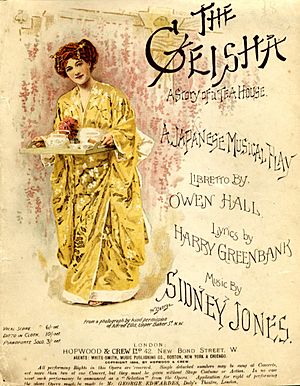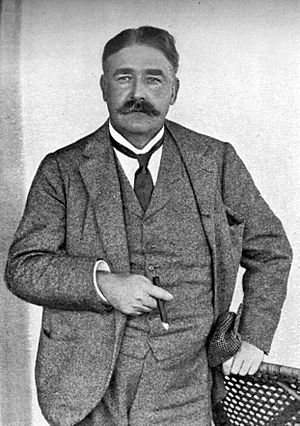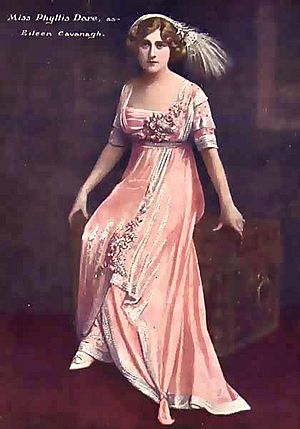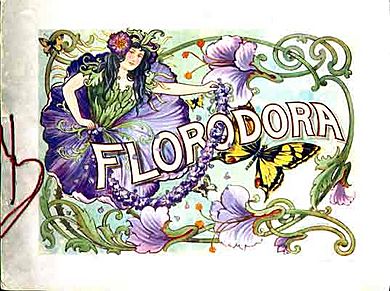Edwardian musical comedy facts for kids
Edwardian musical comedy was a popular type of British musical show. It started in the early 1890s and lasted until after World War I. These shows were big hits before American musicals became famous.
This new style of musical theatre became very popular in Britain. It also spread across the English-speaking world. From In Town in 1892 to The Maid of the Mountains in 1917, these shows ruled the stage. Many successful musicals followed. Some famous ones include The Shop Girl (1894) and The Geisha (1896). Others were Florodora (1899) and A Chinese Honeymoon (1901). Later hits included The Arcadians (1909) and Chu Chin Chow (1916).
Contents
The Story Behind the Shows
Edwardian musical comedy began in the late Victorian era. It captured the hopeful and energetic mood of the new century. These shows also offered comfort during World War I. Before this, two main types of shows were popular. One was the lively but sometimes rude Victorian burlesque shows. The other was the family-friendly Gilbert and Sullivan operas.
Audiences started wanting something new. They liked lighter, more romantic shows. These new musicals were more organized than burlesques. They also showed off the latest fashions and culture.
Meet George Edwardes
The person often called the "father" of Edwardian musical comedy was George Edwardes. People called him 'The Guv'nor'. He took over the Gaiety Theatre in the 1880s. At first, he made the old burlesque shows better. But he soon realized that burlesques were going out of style.
Edwardes then tried a new kind of musical theatre. His shows featured modern clothes and were suitable for families. They had catchy, popular songs and witty, romantic conversations. They also included amazing stage designs. These new shows mixed ideas from Savoy opera and American shows. Their stories were simple and often showed off the latest fashion. They also made fun of social customs in a lighthearted way.
The first Edwardian musical comedy was In Town in 1892. It was a success. Then A Gaiety Girl in 1893 became an even bigger hit. These "musical comedies," as Edwardes called them, changed London theatre. They set the style for the next 30 years. A Gaiety Girl even went on a world tour in 1894. This helped the shows become popular everywhere.
Edwardes' early hits at the Gaiety Theatre often featured a "girl" in the title. These were light, romantic stories. They usually involved a poor girl who falls in love with an aristocrat and wins him over. After A Gaiety Girl, came The Shop Girl (1894) and The Circus Girl (1896). The heroines were often independent young women. They sometimes even earned their own money. The stories usually had a misunderstanding in the first part. By the end, there was always a happy engagement. Critics said Edwardes’ musicals were "Light, bright and enjoyable."
Other "girl" musicals included Our Miss Gibbs (1909) and The Sunshine Girl (1912). To balance these, the Gaiety also had "boy" musicals. Examples are The Messenger Boy (1900) and The Toreador (1901). Edwardes also put on more complex comedy shows at other theatres. The Geisha (1896) and San Toy (1899) were huge international successes. They ran for over two years. These shows used the British interest in Asian culture. Other hits included The Earl and the Girl (1903) and The Quaker Girl (1910).
The Talented People Behind the Scenes
The music in Edwardian musical comedies was often wonderful. It mixed the delicate style of operetta with the catchy tunes of music hall songs. Important composers included Sidney Jones (who wrote The Geisha). Others were Ivan Caryll (Our Miss Gibbs) and Lionel Monckton (The Quaker Girl). Howard Talbot (A Chinese Honeymoon) and Leslie Stuart (Florodora) were also key.
The music was often changed and updated. New songs were added to keep audiences coming back. This was often done by several different composers and lyricists. Important writers included Adrian Ross and Owen Hall. Usually, different people wrote the story, the song lyrics, and the music. This was new for musicals back then. Today, it is a common way to create shows. Adrian Ross wrote lyrics for over 50 Edwardian musicals.
Besides Edwardes, other important people made these shows happen. These included American producer Charles Frohman. Also, actor-managers like Seymour Hicks helped create many hits. The musicals often had a group of actors who worked together regularly. The biggest stars of that time included actresses like Marie Tempest and Gertie Millar. Leading men included Hayden Coffin. Comics like George Grossmith, Jr. made audiences laugh.
Famous Examples of Edwardian Musicals
The Arcadians is often seen as the best example of this type of musical. It was written by Monckton and Talbot. The story is about people from a perfect land called Arcadia. They come to busy London and cause trouble by always telling the truth. This story shows how Edwardian musical comedies fit into theatre history. The Arcadians sing in an operetta style, like the past. The Londoners sing like music hall performers, showing the future. This mix of fancy and everyday style was common in these shows.
Florodora (1899) was a big hit in both Britain and America. So was A Chinese Honeymoon (1901). A Chinese Honeymoon ran for a record 1,074 performances in London. It also played for 376 shows in New York. The story is about couples who go to China for their honeymoon. They accidentally break the local laws about kissing.
Later, other shows became hugely popular. Chu Chin Chow (1916) ran for an amazing 2,238 performances. This was more than twice as long as any musical before it. The Maid of the Mountains (1917) was the second longest-running Edwardian musical. It had 1,352 performances. During World War I, people wanted light and happy entertainment. These shows gave them exactly that.
George M. Cohan's Little Nellie Kelly (1922) is sometimes thought of as one of the last Edwardian musical comedies.
|





